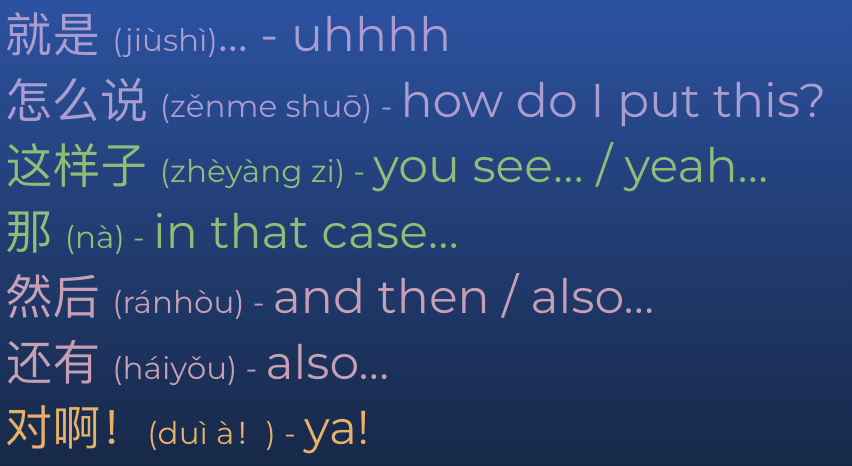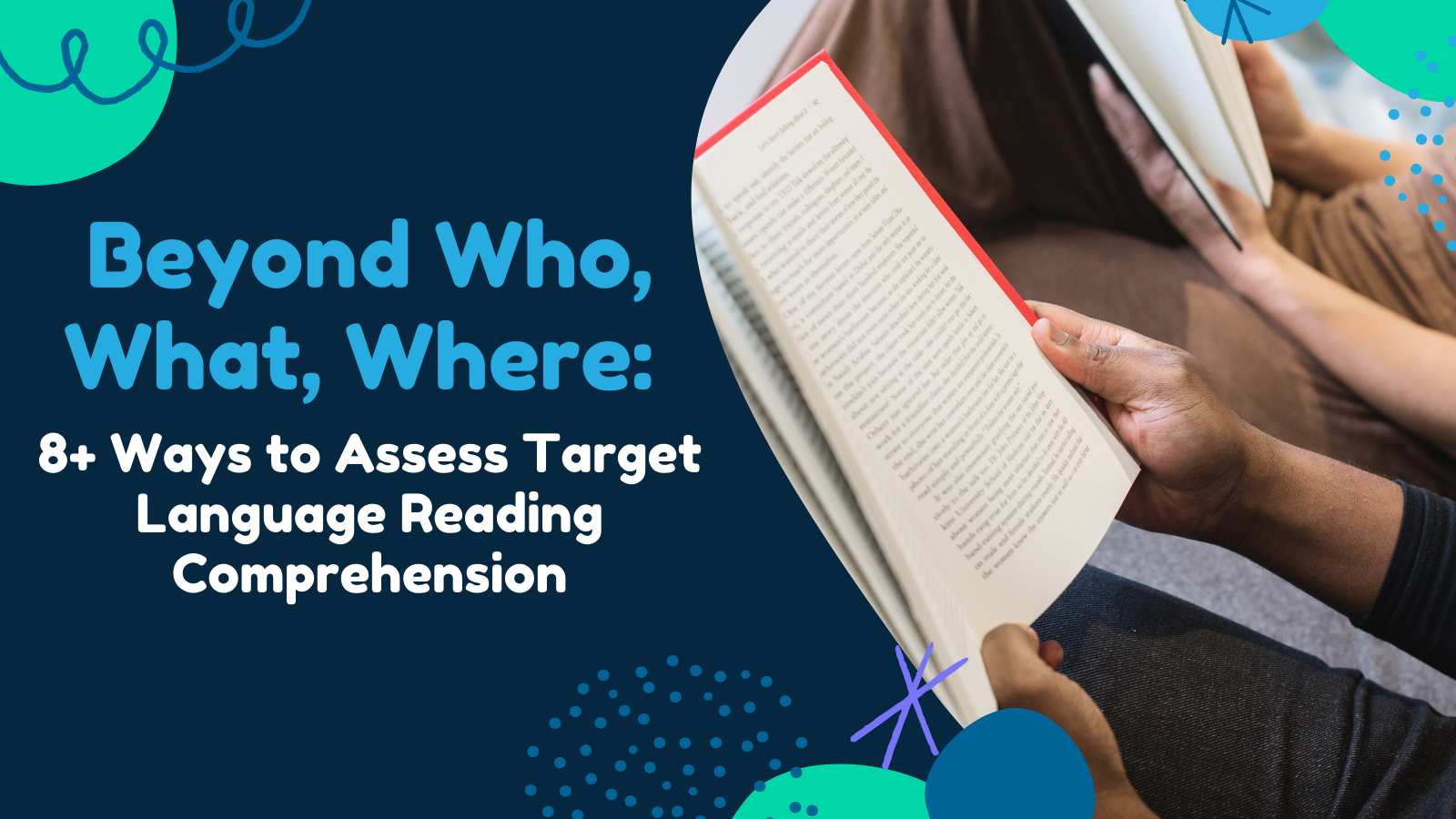
In one of our most recent blogs, I wrote about different ways to assess target language reading comprehension. You know, beyond the basic 'who, what, where' questions. This new blog can be seen as its companion piece. As reading is one of the two forms of input, in this post we will cover assessments on Extempore for the other input-based skill, listening.
For more about this blog, watch our Blog Breakdown video below.
As we dive into listening assessments, I want to look at a quote I've referenced in previous webinars but I feel deserves revisiting for this blog.
“Even though the other skills such as reading, speaking and writing are essential to develop language proficiency, listening contributes primarily for language expertise. Listening awakens awareness of the language as it is a receptive skill that first develops in a human being. Learning to listen to the target language improves language ability. The sound, rhythm, intonation, and stress of the language can only be perfectly adapted through listening. To understand the nuances in a particular language, one must be able to listen. As we get to understand spoken language by listening it is easier to improve the other skills and gain confidence… listening helps the language learner to understand the beauty of the language. Especially in terms of communicative language teaching, it is said that the basis for communicative competence is listening as it provides the aural input and enables learners to interact in spoken communication and hence language learning largely depends on listening. Thus listening forms the concrete basis for the complete language proficiency.” (Renukadevi, 2014) [emphasis added]
There's a lot to unpack here, but the message is clear: building listening skills among students is essential for their proficiency in the TL. For all we hear about reading, listening provides just as much. After all, it's the first skill that we develop as humans and establishes the foundation of all other linguistic skills.
And yet!
“Listening, unlike the other language skills, is felt comparatively much difficult by the learners, as it has all its interrelated subskills such as receiving, understanding, remembering, evaluating, and responding.” (Renukadevi, 2014) [emphasis added]
and...
“Listening activities generally induce the anxiety and stress among the learners as it involves the interpersonal and interpretive modes of communication in which [students have] to actively participate.” (Renukadevi, 2014)
There's no other way around it; listening is hard. With reading, it's a relatively consistent (but by no means easier) experience for students. Students read at their own pace and have much greater control over the input they are receiving. Sure, writing styles can vary (informational text, formal letter, casual dialogue, etc.) but the same can be said for listening. Listening, on the other hand, presents a host of factors that can (and often will) vary each time and are seldom present in TL reading materials, including
- How fast the speaker speaks.
- Accents and regional pronunciations.
- Quirks of speech like elision and filler words.
- How many times the student hears the clip.
It should be noted that resources for listening practice and assessment (audio clips and video) found in common language textbooks tend to avoid the above, eschewing the nuance of everyday spoken language for clear, 'standard' (whatever that means) pronunciation, lest students realize that what they are hearing doesn't match this 'standard' language.* At least, this has been my own experience learning both Spanish and Chinese, and from observing modern textbooks.
There's no other way around it; listening is hard.
With all this in mind, let's look at some example listening assessments on Extempore. These tasks present themselves in a variety of ways, and the listener's role in comprehension will differ depending on the (mostly) real-world situation. Some involve purely understanding (interpretive communication), while others involve understanding and needing to respond in the TL (interpersonal communication).
*There are obvious reasons for why these are omitted, but it only leaves students perplexed when they hear 'real [insert language],' leaving them with thoughts like why was I never taught that 'mi hijo' is actually spoken as 'mijo'???
Assessment 1: Understand a Short Message
For these assessments, students need to show that they accurately interpreted the brief TL message. I can think of a few situations where learners have to understand a short message (one that does not merit a TL response), and most of them occur in public locales. Airports, schools, train stations, buses, metros, even some shops: all of these places have frequent, but also short (15-60 second) public address announcements.
How can students show their comprehension?
As I mentioned in the reading assessments blog, posing unique multiple choice questions (written not in the TL but in the shared language) offers a reliable (and easily scorable) route. The example below features the following questions.

- Where might one hear this type of announcement? (linguistic awareness)
- What information was not included in this announcement? (interpretive ability)
- What phrase was mentioned in the announcement? (vocabulary identification)
- I put the answers in the TL for this question (pictured on the right) to further prompt students to pair what they heard to the Chinese characters (i.e., they have to know how the answers are pronounced in order to select the correct answer).
- Which of the following would be a logical response to this announcement?
- Here, there are four different audio clips for the student to listen to and decide which one is the most appropriate.
- Likewise, you could flip this question and ask what would not be a logical response, with all but one of the choices being appropriate.
Assessment 2: Understand a Long Message (listen for entertainment)
The assessment above showcased an example where students listen to understand, and there is no need to respond. In this second example, students are doing the same thing, except they are listening for a bit longer. Upon thinking about what situations involve listening to the TL for longer periods of time, I immediately thought of entertainment. Think about watching TV shows or YouTube videos, listening to music or poetry, or enjoying a movie. All of these are ways we can listen to the TL for entertainment without having to respond to it. And normally, we listen for much more than just 30 seconds. As such, there are plenty of ways to assess comprehension of pieces of entertainment, all of which will require the students' undivided attention.
How can students show their comprehension?
Since there is a bit more content at play here, there are more options for assessing comprehension. For example, you could even have students discuss the subject matter (video clip, song, poem) in your class's shared language, whether it be the factual content or their opinions of it. The example below features the following questions.

- Where is the narrator most likely located? (linguistic awareness)
- The narrator of the poem likely feels... (inferences)
- Which of the following does the narrator not reference in the poem? (identifying vocabulary)
- What would you say is the narrator's message? (interpretive skills, with response in shared language)
Assessment 3: Listen to understand and respond in TL (interpersonal communication)
The two above assessments are one-way streets: students listen to understand, and the TL interaction stops there. That is, outside of demonstrating their TL understanding (answering questions and writing a bit in the shared language), there is no other linguistic obligation required from them in the TL. That's interpretive communication! Add another 'lane' to these assessments, though, and you have a two-way, interpersonal assessment. Now, students not only have to understand what they hear, but they have to process it, think of a logical response, and then produce one in the TL. All of this in a very short amount of time.
How can students show their comprehension?
When assessing interpersonal communication (or presentational, for that matter), we must prioritize meaning. Does the student produce a logical response? Do the patterns and vocabulary they use make it (mostly) comprehensible? If we can say 'yes' to both of those questions, then the student has properly communicated. Rubrics come into play when we start looking at the degree to which students 1) completed the response task and 2) were comprehensible in their output.
Example on Extempore
There are many ways to host interpersonal speaking assessments on Extempore. One involves a basic question and answer format, where students simply answer one question at a time and then move on to the next one in the assessment. Another option involves our synchronous assessment option where your students can join a room and talk to each other in real time. One other option, however, involves hosting a simulated conversation, commonly seen in the AP world language examinations. That's what we'll be looking at below.

In a simulated conversation, there is only one prompt to which the student responds. The catch is that within this prompt, there is an audio file with pauses added in between questions and statements from the student's interlocutor. The student starts recording on their side, listens, and then engages in the conversation, all of which gets recorded for instructor review.
When creating these, don't be afraid to provide your students with filler words or transition phrases that they can refer to while they are speaking. I like to screenshot a set that I have and then add them in as an image to the prompt on Extempore. These will only improve their speech, yet they won't be the difference between a logical and illogical response. With enough exposure and repetition, students will eventually internalize them as part of their TL vocabulary.

Assessment 4: Listen to understand and Mediate in the Shared Language
I won't go on too much about mediation as I have written about it in a previous post. It's simple -- students serve as the mediator for another individual who cannot communicate in the target language. This situation is more common than you think. If you (a Spanish speaker) are travelling with someone in Guatemala who cannot speak Spanish, there's a good chance you will have to help them complete basic tasks that involve using Spanish.
How can students show their comprehension?
By taking the language they hear and sharing that information in their shared language, the student can demonstrate interpretive comprehension. For more, watch the video below.
Short assessments are the way to go
You probably noticed these assessments are very short, just 3-4 questions each. Realistically, that's all you need. I don't need 15 multiple choice questions to know how much my students understood from the text. This is why we ask detailed and in-depth questions that ensure students understand what they hear (for multiple choice, it's also a great reason to add more than four possible choices).
There you have it! Four unique yet practical listening assessments you can use with your students. Try them out and modify them however you want. How else might you assess listening? What assessments might you change from before? We're all ears.
Works Cited
Renukadevi, D. (2014). The role of listening in Language Acquisition; the Challenges & Strategies in Teaching Listening. International Journal of Education and Information Studies. 4 (1), 59-63.



